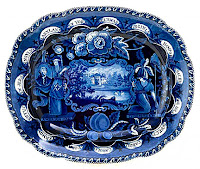 QUESTION: My passion for collecting seems to becoming an obsession. How can I control this? And how can I judge what things are worth collecting?
QUESTION: My passion for collecting seems to becoming an obsession. How can I control this? And how can I judge what things are worth collecting?
ANSWER: You’ve obviously been bitten hard by the collecting bug. Ever since the launching of the Antiques Roadshow and Pawn Stars, as well as eBay, Ruby Lane, and other antiques and collectibles, many people think that everything is worth something. And if something is old, it must certainly be valuable. If you believe this, then you’re wrong on both counts.
The first question you need to ask yourself is “Why do you collect things?” Is it for their intrinsic or monetary value, is it for the pleasure they give you, or is it for some vague idea of self-worth?
 Asking avid collectors why they do what they do is like asking, "Why do you breathe?" They might reply that something about human behavior wants—or is fated—to gather and accumulate, to crave and classify, to seek out and hoard. Passion plays a part in many serious collectors' pursuits, as does, many admit, the thrill of the hunt.
Asking avid collectors why they do what they do is like asking, "Why do you breathe?" They might reply that something about human behavior wants—or is fated—to gather and accumulate, to crave and classify, to seek out and hoard. Passion plays a part in many serious collectors' pursuits, as does, many admit, the thrill of the hunt.
This can be true even, or perhaps especially, when time is long between looking, finding and acquiring. The rarer an object of desire, the less frequent or instant the gratification of its discovery; for some determined collectors, though, pleasure resides in the long, unpredictable search for a coveted item. Inexplicably, it may also dissolve when it leads to a find.
 For many people, collecting is a way of getting in touch with a past era, even if they didn't live through that particular period themselves. Some enjoy owning objects from what they may imagine was a simpler, less stressful age. Or they may have a strong nostalgic or family connection to a certain period and place.
For many people, collecting is a way of getting in touch with a past era, even if they didn't live through that particular period themselves. Some enjoy owning objects from what they may imagine was a simpler, less stressful age. Or they may have a strong nostalgic or family connection to a certain period and place.
Some people collect with investment value in mind, others to develop an informed knowledge of a our material culture. Either way, passion plays a part in many serious collectors' pursuits, as does the thrill of the hunt. Identifying personally with the objects one admires can also feed the collecting impulse.
Some collectors embrace—and celebrate—their magnificent obsessions. Like entertainers, they enjoy displaying what they have amassed and sharing their enthusiasm with friends. Conversely, many people keep their treasured collections to themselves.
Collecting has broaden in scope over the decades. It used to be that antiques included only decorative objects and furnishings. Today, collectors consider any object 100 years old or older an antique. Anything newer a collectible. And while some antiques may be considered collectibles, not all collectibles are antiques. Take typewriters, for instance. The oldest ones are antiques but newer ones from the late 20th century are technically collectibles.
 What's old is new in the evermore-diverse collectibles market, and as long as someone, somewhere values something enough to acquire it and stimulate trading in its field, it can become a common practice to do so. Thus, along with such old favorites as stamps and coins, items like Barbie dolls, comic books, and computers, in fact, just about everything can be deemed a collectible.
What's old is new in the evermore-diverse collectibles market, and as long as someone, somewhere values something enough to acquire it and stimulate trading in its field, it can become a common practice to do so. Thus, along with such old favorites as stamps and coins, items like Barbie dolls, comic books, and computers, in fact, just about everything can be deemed a collectible.
So where do you draw the line. The first rule of collecting is collect what you like. The second rule is to be knowledgeable about your collection. The third rule is buy low and sell high.
Understand why you’re collecting what you do. What got you started? Have you kept up with your collection or has it run its course? If your collection is languishing, then perhaps you’ve lost interest. Life changes. You change.
Do you know a lot about what you collect? Have you studied up on the history of the objects? Do you know the makers and the marks? Do you know the last word on the subject? Have you kept up with the market value?
 Too many people get caught up in the entertainment value of auction sites like eBay. For some it’s like playing poker. They even get to “win.” Many pay far more than an object is worth just because they want to be the winner. If you’re a true collector, you’ll not even bid on an item unless you know you can get it for a good deal below market value. And that means you have to know what it’s worth before you bid.
Too many people get caught up in the entertainment value of auction sites like eBay. For some it’s like playing poker. They even get to “win.” Many pay far more than an object is worth just because they want to be the winner. If you’re a true collector, you’ll not even bid on an item unless you know you can get it for a good deal below market value. And that means you have to know what it’s worth before you bid.
Do you just collect things or do you keep an inventory of your collection? To understand the true value of your collection, you need to know when and where you purchased each piece, how much you paid and how much it’s worth now. You may even want to photograph each item as a record for insurance purposes.
Of course, as any collector knows, there’s a price to pay. Thus, beginners and seasoned veterans alike usually pursue their collecting passion at some cost. No matter what your field is, there's something all of us inevitably collect and unless you pick the pieces off the junk pile, you’ll have to pay for them.
To read more articles on antiques, please visit the Antiques Articles section of my Web site. And to stay up to the minute on antiques and collectibles, please join the over 30,000 readers by following my free online magazine, #TheAntiquesAlmanac. Learn more about railroad antiques in "All Aboard!" in the 2021 Summer Edition, online now. And to read daily posts about unique objects from the past and their histories, like the #Antiques and More Collection on Facebook.

















































